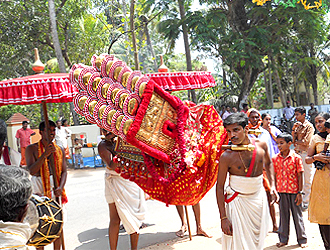 Kuthiyottam is the single largest and unique devotee offering that is prevalent in Kerala in terms of the expenditure involved. Children between 8 to 14 years are taught Kuthiyottam. On the day of Bharani early in the morning, after the feast and other rituals, the boys whose body is pierced with a silver wire, one end of which is tied around his neck and an arecanut fixed on the tip of a knife. It is held high over his head and these boys are taken in procession to the temple accompanied by beating of drums, music, ornamental umbrellas and other classical folk art forms as well as caparisoned elephants.
Kuthiyottam is the single largest and unique devotee offering that is prevalent in Kerala in terms of the expenditure involved. Children between 8 to 14 years are taught Kuthiyottam. On the day of Bharani early in the morning, after the feast and other rituals, the boys whose body is pierced with a silver wire, one end of which is tied around his neck and an arecanut fixed on the tip of a knife. It is held high over his head and these boys are taken in procession to the temple accompanied by beating of drums, music, ornamental umbrellas and other classical folk art forms as well as caparisoned elephants.
On the way to the temple coconut water is poured on his body continuously. Thereafter the boys stand at a position facing the Sreekovil and start dancing. This ritual ends with dragging the wire pierced to the skin and few drops of blood come out. The training starts about one to two months before the season starts.
The movements and formations of dancers choreographed in Kuthiyottam are quick reaches at a particular point and ends abruptly. The traditional songs start in a slow pace thereby gains momentum and ends abruptly.
Post midday the residents of the locality bring huge decorated effigies of Bhima panchali, Hanuman as well as tall chariots in wheeled platforms. After darshan, the parties take up their respective position in the paddy fields lying east of the temple. In the night Devi`s image will be carried in procession to the effigies stationed in the paddy fields. These are taken back next day. Kuthiyottam is the main offering of the Chettikulangara temple, Mavelikkara in Kerala.
Kuthiyottam is a rare folklore. The songs that are sung are in four rhythms known as `Padams`, and it is compulsory to sing all the four every day. The songs elaborate on the great deeds of Bhagavathi as to how she killed Asuras like Sumbani Sumbas, Darika and aims to please her by singing her virtues. Kuthiyottam is an emblematic representation of human sacrifice. The Bharani Utsava is celebrated in the months of February, March in this temple that is quite an event to the local people as well as to those residing in the neighbouring areas.





















